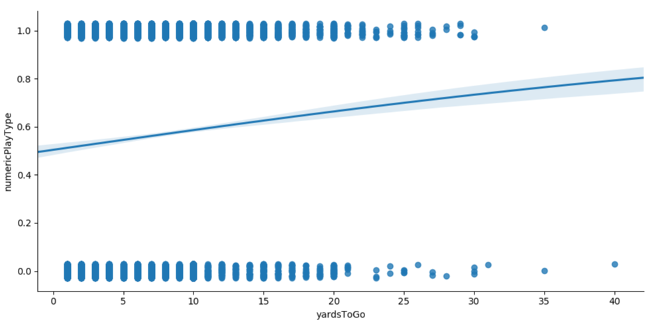python数据分析和预测
如果您完成了第1部分 ,那么恭喜! 您有耐心格式化数据。 在那篇文章中,我使用了一些Python库和一些基本的足球知识来清理我的国家橄榄球联盟数据集 。 从我离开的地方开始,是时候仔细看看我的数据集了。
数据分析
我将创建一个仅包含要使用的数据字段的最终数据框。 这些主要是除向下和距离(aka yardsToGo )外,我在转换列时创建的数据字段。
df_final
= df
[
[
'down'
,
'yardsToGo'
,
'yardsToEndzone'
,
'rb_count'
,
'te_count'
,
'wr_count'
,
'ol_count'
,
'db_count'
,
'secondsLeftInHalf'
,
'half'
,
'numericPlayType'
,
'numericFormation'
,
'play_type'
]
]
现在,我想使用dataframe.describe()来检查我的数据。 它可以对数据框中的数据进行汇总,从而更容易发现任何异常值。
print ( df_final. describe ( include = 'all' ) )

除了yardsToEndzone的计数比其余各列的计数低之外,大多数内容看起来都不错。 dataframe.describe()文档将计数返回值定义为“非NA /空观测值的数量”。 我需要检查我是否有空的码线值。
print ( df. yardlineNumber . unique ( ) )
为什么会有nan值? 为什么我似乎缺少一条50码的线? 如果我不了解,我会说我从NFL转储中得到的未稀释数据实际上并没有使用50码线作为值,而是将其标记为nan。
以下是一些码数为NA的比赛的比赛描述:

看来我的假设是正确的。 每个比赛描述的结束码和获得的码数均为50。完美(为什么?!)。 我将从上次在yards_to_endzone函数之前添加一行来将这些nan值映射到50。
df [ 'yardlineNumber' ] = df [ 'yardlineNumber' ] . fillna ( 50 )
再次运行df_final.describe() ,我现在全面获得了统一计数。 谁知道如此大量的实践只是在研究数据? 当它带有神秘感时,我会更喜欢它。
是时候开始我的可视化了。 Seaborn是一个有用的用于绘制数据的库,我已经在第1部分中将其导入。
播放类型
完整数据集中有多少场传球和奔跑?
sns.
catplot
( x
=
'play_type'
, kind
=
'count'
, data
= df_final
, orient
=
'h'
)
plt.
show
(
)
看起来传球比奔跑的游戏多出1000多个。 这很重要,因为这意味着两种播放类型之间的分配不是50/50的分配。 默认情况下,每个分组的传球次数应比跑步次数多一些。
丘陵
失败是指球队可以尝试比赛的时期。 在NFL中,进攻要经过四次尝试(称为“下降”)才能获得指定的码数(通常从10码开始)。 如果没有,则必须将球传给对手。 是否有特定的下降趋势,往往会有更多的传球或奔跑(也称为奔跑)?
sns.
catplot
( x
=
"down"
, kind
=
"count"
, hue
=
'play_type'
, data
= df_final
)
;
plt.
show
(
)
第三局比传球要多得多,但考虑到初始数据的分布,这可能毫无意义。
回归
我可以使用numericPlayType列来发挥自己的优势,并创建一个回归图以查看是否存在任何趋势。
sns.
lmplot
( x
=
"yardsToGo"
, y
=
"numericPlayType"
, data
= df_final
, y_jitter
=
.03
, logistic
=
True
, aspect
=
2
)
;
plt.
show
(
)

这是一个基本的回归图,表示走的码数越大,数字游戏类型就越大。 如果播放类型为0进行奔跑,传递类型为1进行传球,则这意味着要覆盖的距离越远,该播放就越可能成为传递类型。
模型训练
我将使用XGBoost进行培训; 它要求输入数据必须全部为数字(因此,我必须删除可视化中使用的play_type列)。 我还需要将数据分为训练,验证和测试子集。
train_df
, validation_df
, test_df
= np.
split
( df_final.
sample
( frac
=
1
)
,
[
int
(
0.7 *
len
( df
)
)
,
int
(
0.9 *
len
( df
)
)
]
)
print
(
"Training size is %d, validation size is %d, test size is %d" %
(
len
( train_df
)
,
len
( validation_df
)
,
len
( test_df
)
)
)
XGBoost采用特定的数据结构格式的数据,我可以使用DMatrix函数创建该格式 。 基本上,我将numericalPlayType声明为要预测的标签,因此我将向该数据集提供没有该列的干净数据集。
train_clean_df
= train_df.
drop
( columns
=
[
'numericPlayType'
]
)
d_train
= xgb.
DMatrix
( train_clean_df
, label
= train_df
[
'numericPlayType'
]
,
feature_names
=
list
( train_clean_df
)
)
val_clean_df
= validation_df.
drop
( columns
=
[
'numericPlayType'
]
)
d_val
= xgb.
DMatrix
( val_clean_df
, label
= validation_df
[
'numericPlayType'
]
,
feature_names
=
list
( val_clean_df
)
)
eval_list
=
[
( d_train
,
'train'
)
,
( d_val
,
'eval'
)
]
results
=
{
}
其余设置需要一些参数调整。 不必太草率 ,预测运行/通过是一个二进制问题,我应该将目标设置为binary.logistic 。 有关XGBoost所有参数的更多信息,请参阅其文档 。
param
=
{
'objective' :
'binary:logistic'
,
'eval_metric' :
'auc'
,
'max_depth' :
5
,
'eta' :
0.2
,
'rate_drop' :
0.2
,
'min_child_weight' :
6
,
'gamma' :
4
,
'subsample' :
0.8
,
'alpha' :
0.1
}
针对我的PC的一些侮辱性侮辱,以及后来的两部分系列( Python的哭泣 ),我正式准备训练我的模型! 我将尽早停止一轮,这意味着如果模型训练的评估指标在八轮之后下降,我将结束训练。 这有助于防止过度拟合 。 预测结果表示为结果为1(传球)的概率。
num_round
=
250
xgb_model
= xgb.
train
( param
, d_train
, num_round
, eval_list
, early_stopping_rounds
=
8
, evals_result
= results
)
test_clean_df
= test_df.
drop
( columns
=
[
'numericPlayType'
]
)
d_test
= xgb.
DMatrix
( test_clean_df
, label
= test_df
[
'numericPlayType'
]
,
feature_names
=
list
( test_clean_df
)
)
actual
= test_df
[
'numericPlayType'
]
predictions
= xgb_model.
predict
( d_test
)
print
( predictions
[ :
5
]
)
我想看看我的模型使用四舍五入的预测(到0或1)和scikit-learn的指标包的准确性。
rounded_predictions
= np.
round
( predictions
)
accuracy
= metrics.
accuracy_score
( actual
, rounded_predictions
)
print
(
"Metrics: \n Accuracy: %.4f" %
( accuracy
)
)
使用Python及其丰富的库和模型,我可以合理地预测播放类型的结果。 但是,仍有一些我没有考虑的因素。 国防人员对比赛类型有什么影响? 比赛时的得分差异如何? 我想总是有空间检查您的数据并进行改进。 las,这就是程序员变成数据科学家的生活。 是时候考虑提前退休了。
翻译自: https://opensource.com/article/19/10/predicting-nfl-plays-python
python数据分析和预测





















 7055
7055











 被折叠的 条评论
为什么被折叠?
被折叠的 条评论
为什么被折叠?








